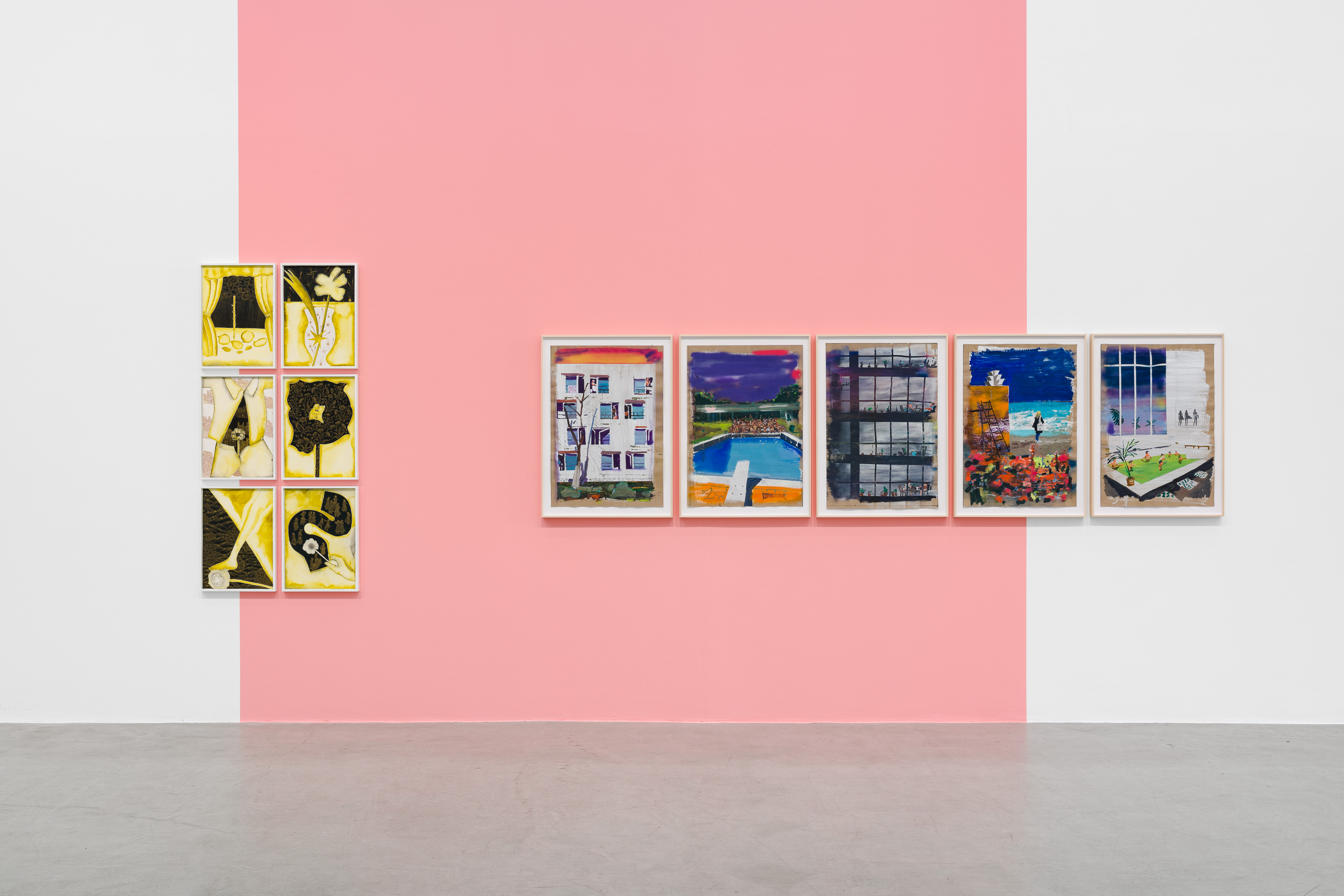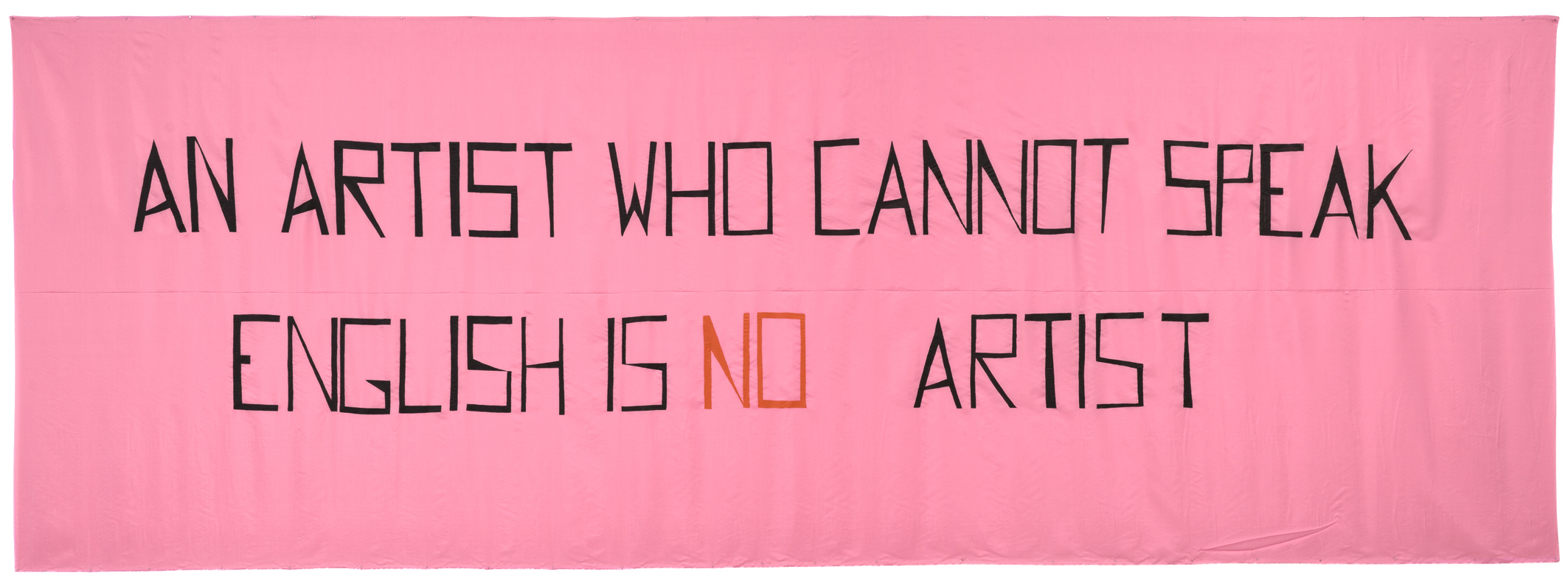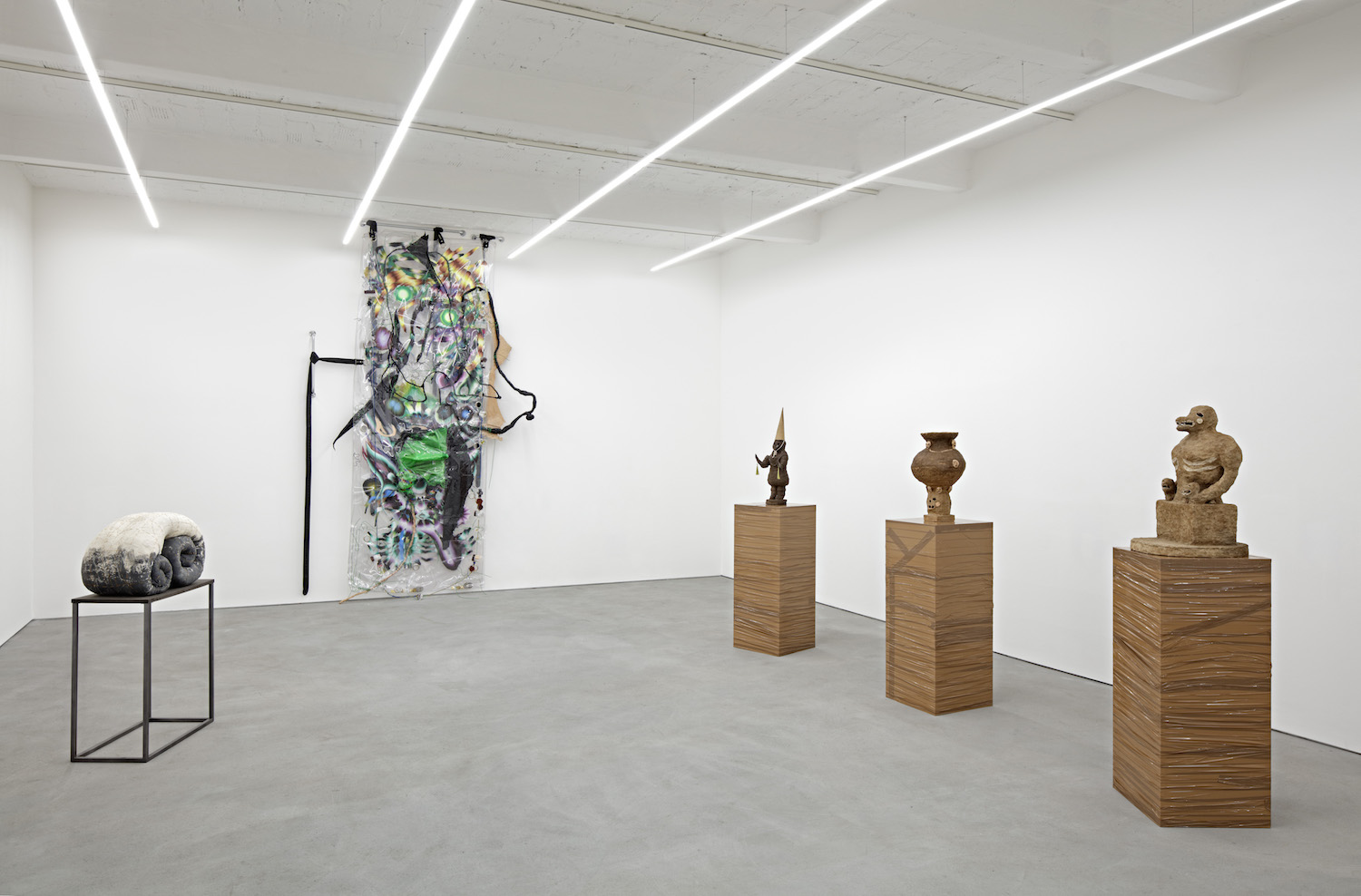
This summer ChertLüdde is hosting Friend Of A Friend, a collaborative gallery project co-organised by Stereo and Wschód that originally took place in Warsaw earlier this year. Eight galleries have each brought one artist to the space to form a show that hints at the advanced technologies that support the human existence, whilst also feeling a little mystical. On the ground floor, Violet Dennison’s (Galerie Jan Kaps) piece dominates the wall. Set on aluminium panels, copper-coated genetically modified seeds are arranged to map the areas in her studio with the highest levels of dangerous radiation. Tagged with passive Radio Frequency Identification (RIFD) tags, the seeds make the artwork itself trackable. Suggestions of the quiet or unnoticed systems that make up our world continue upstairs, as a projector ticks away showing an untitled film by Joanna Piotrowska (Galeria Dawid Radziszewski) in which a pair of hands make gestures inspired by a touch therapy technique for those with autism. The participating galleries are: Foksal Gallery Foundation, Lucas Hirsch, Jan Kaps, Antoine Levi, Dawid Radziszewski, Stereo and Wschód. (Rosalind Duguid)
Until 1 September

Doodle & Disegno at Blain Southern Berlin
Works on paper are often overlooked, relegated to viewing rooms rather than the main exhibition, shrugged off as drafts or—as this show’s title pointedly highlights—mere doodles. Paper is evocative for many of us, from the scent of fresh school notebooks to the distinctive rustle of the broadsheet newspaper. This wide-ranging exhibition at Blain Southern takes paper as its unifying principle, bringing together artists who are best known for their work in many mediums beside the humble page, from Jake & Dinos Chapman to Bill Viola. The versatility of paper is immediately evident here, seen in everything from John Stezaker’s signature photo collages to “blind” self-portraits drawn in ink by Tim Noble and Sue Webster. It is a leveller, as open-ended as it is inclusive. (Louise Benson)
Until 15 September

Kara Walker’s 2011 seventeen-minute video, Fall From Grace, Miss Pipi’s Blue Tale, currently showing at Sprüth Magers, isn’t easy to watch: when the sexual relationship between the protagonist, Miss Pipi, a stereotypical Southern Belle, and an anonymous black man, is discovered, he is beaten, castrated and killed by a group of white vigilantes. The story is told using shadow puppets—a method Walker has used in other films—adding to the complex notions of the psychology of blackness that the film posits in such a devastating way. The best part of a decade on, the work still has a harrowing effect—a rumination on racism and violence, but also beauty and survival. (Charlotte Jansen)
Until 8 September
![Dineo Sheshee Bopape, Untitled (Of Occult Instability) [Feelings], 2016–18, installation view, 10. Berlin Biennale, KW Institute for Contemporary Art, Berlin, courtesy Dineo Seshee Bopape; Jabu Arnell; Lachell Workman; Mo Laudi; Robert Rhee; Sfeir-Semler Gallery, Hamburg/Beirut, photo: Timo Ohler](https://elephant.art/wp-content/uploads/2018/08/bb10-dineo-sheshee-bopape_04-Edited.jpg)
A tornado has seemingly swept through the central room of the KW Institute for Contemporary Art in Berlin as part of the 10th Berlin Biennale, in which the complex and powerful installation by South African artist Dineo Sheshee Bopape unfurls. It draws on South African author Bessie head’s novel A Question of Power (1973)—concerning a woman’s descent into insanity—and Nina Simone’s 1976 performance of Feelings at the Montreux Jazz Festival—an inquiry into mental instability. The resulting work is a schizophrenic collage of found objects including bricks and pillars, playlists scrawled on napkins and borrowed footage of Simone’s performance, plus the additional works of three artists invited by Bopape, all laid bare beneath a surreal orange glow. Haunting and multilayered, it fits well within the tenth Berlin Biennale, which this year is titled after Tina Turner’s 1985 song We Don’t Need Another Hero, resisting historical precedent to create a space for second-guessing, active unlearning and alternative mythologies. (Alice Bucknell)
Until 9 September

Hello World at Hamburger Bahnhof
Set aside an entire day, because the ambition of this exhibition is not small: how can we revise the way museum collections are framed in the west? The curatorial team (comprised of thirteen curators) behind this mammoth group exhibition, Hello World, has compiled thirteen “chapters” in response, imagined through more than 250 artists. The Nationalgalerie—which is responsible for five major museums in Berlin—and its role in Germany’s social, cultural and political positioning in the world since its founding in 1861 is dissected in a visionary, if at times confusing, manner—they’ve done away with timelines, borders and chronology—all typical tropes of the museum—and instead invite more fluid meanderings that eschew and contradict the western gaze of European cultural institutes. (Charlotte Jansen)
Until 26 August

You Are Just a Piece of the Action at Salon Dahlmann
As we spend ever-more time tied to our digital devices, exactly what impact is our evolving lifestyle having on our bodies? We take public transport to work but pay for gym workouts, and track our every step via smart watches. Our data is increasingly recognised as one of our most valuable commodities, and yet we are unable to get a handle on its rapid circulation online. Scientific and technological progress sweeps us along, but we find ourselves relegated to “just a piece of the action”—an Andy Warhol quote from which this exhibition at Salon Dahlmann takes its title. The show takes a trip through the work of more than ten artists exploring the body in the age of acceleration, including iconic figures like Ulay, as well as such names as Jesse Wine, Elina Brotherus and Aurora Reinhard. Together, they range from forays into science-fiction to bio-tech and body modification. (Louise Benson)
Until 1 September

Augmented Sunrise Beneath the Skin at Gr_und
Neon text signs, polyurethane sculptures, and virtual reality installations characterize Augmented Sunrise Beneath The Skin, an international group exhibition featuring ten artists whose practices are based in the unlikely pairing of Berlin and Miami. Honing in on the sweltering summer states and dreamlike narratives propagated by both cities, the exhibition’s curator, GeoVanna Gonzalez, hones in on the deeper link between the diverse countercultural forces shaping both cities in a digitally-mediated, post-global and fair-and-FOMO-driven art economy. Digging beneath the neon highs of Miami’s “lush maximalism” and Berlin’s “brutalist oasis,” the works collectively assess the operating logic of both cities. It dissolves the oceanic distance between these cities by tapping into the blurred boundaries between virtual and physical realms, as well as the automated codes and digital organizing bodies that together configure our cities and homes, shaping our interactions with one another. (Alice Bucknell)
Until 1 September

Chthonic Rift at Kraupa-Tuskany Zeidler
The underworld comes up to play in this group exhibition at Kraupa-Tuskany Zeidler. Chthonic Rift turns the gallery into a museum of almost-ancient artefacts and other-worldly objects, accompanied by the eerie sounds of Marguerite Humeau’s “Kamoya (KNMER1813)”. Standout paintings by Canadian artist Ambera Wellmann glisten like rubber or cheap china, a fleshy counterpoint to the stripped-back abstracted bodies in the work of the late Anu Põder. Slightly cute, iconic sculptures made of similarly low-fi materials reflect the folklore of Tuva, the Siberian region of artist Evgeny Antufiev’s childhood, whilst huge hanging works by KAYA appear to have been dredged up from some kind of acid rave swamp. Chthonic means relating to the underworld, but this exhibition does not feel wholly dark or hellish—instead it attempts to bridge the divide between all things “low” and “high”. (Rosalind Duguid)
Until 7 September





